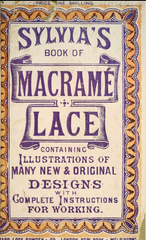The Art of Knotting: Unraveling the History of Macramé
Macrame, an art form that involves knotting cords or strings to create decorative patterns, has a long and fascinating history. The exact origins of macrame are unclear, but it is believed to have originated in the Middle East and spread to other parts of the world through trade and migration. The earliest known use of macrame dates back to the 13th Century, when Arab weavers used the technique to create intricate decorative fringes on their textiles.

Macrame in the 19th Century
In the early 19th Century, sailors used macrame for everyday uses, including securing cargo and making safety nets. As the sailors traveled the world, macrame techniques gained popularity and their usage spread.
By the mid-1800s, Europeans used macrame to embellish clothing, curtains, and other household items. The Victorians were particularly fond of macrame and often used it to decorate tea cozies, lampshades, and other decorative items. The famous Sylvia's Book of Macramé Lace (1882) showed how "to work rich trimmings for black and coloured costumes, both for home wear, garden parties, seaside ramblings, and balls—fairylike adornments for household and underlinens ..." By the early 1900s, macrame fell out of favor for personal use as people began to favor more modern, streamlined styles.

Sylvia's Book of Macrame Lace, The Smithsonian Library
Macrame in the 20th Century
Bauhaus Movement (1919 - 1933)
The Bauhaus School movement arose from the German art school founded by Walter Gropius in 1919, which combined crafts and fine arts. The charter of the Bauhaus stated that "any person of good repute, without regard to age or sex … will be admitted," but when female applicants unexpectedly threatened to equal or even outnumber male applicants, the masters at the school agreed to limit their numbers and channel women exclusively into the pottery, bookbinding, and weaving workshops. The head of pottery resisted, and the bookbinding department was closed, leaving weaving as the main focus for the female students. Anni Albers is one artist from the Bauhaus School who used macrame in her fiber art.

Anni Albers weaving sample, Anni Albers Foundation
Mid to Late Twentieth Century
However, in the 1960s, macrame experienced a resurgence in popularity, thanks partly to the hippie movement and the popularity of bohemian fashion. Creatives used macrame to create everything from wall hangings and plant hangers to belts and jewelry. It was a way for people to express their individuality, and it became associated with the counterculture movement of the time. Mary Walker Phillips is one of the best-known fiber artists of this time. While she is primarily known as a knitting artist, Phllips' transition from traditional weaving to knitting and macrame is often credited for moving fiber arts from utility to art. Her book, Step by Step Macramé (1970), is considered a classic in teaching macrame techniques.
Contemporary Macrame
Today, macrame continues to be a popular form of art and craft. Artists and artisans use macrame to create various items, including fiber art installations, clothing, home decor, and jewelry. Recently, there has been a renewed interest in macrame, with many people turning to it as a way to disconnect from technology and engage in a more tactile and hands-on form of creativity. I started The Stitch Alliance during the COVID-19 pandemic while looking for a hands-on activity that only took up a little space.
One of my favorite contemporary macrame artists is Tanya Aguiñiga, a self-described artist, activist, mother, educator, and maker. Tanya creates large-scale fiber pieces using found objects and natural materials. Museums worldwide have featured Aguiñiga's work, including The Noguchi Museum in New York and the Oakland Museum of Contemporary (OCMA) Art in Oakland, CA. Aguiñiga also founded the AMBOS (Art Made Between Opposite Sides) Project, a platform for art about identity and transition at the US/Mexico border.
Matriarchal Womb, 2022 by Tanya Aguiñiga
Another area where contemporary macrame has particularly flourished is in the world of jewelry. Artisans create macrame jewelry using various cord types adorned with gemstones, shells, or other decorative elements. The versatility of macrame means endless possibilities for creating jewelry, and many artisans have made a name for themselves by specializing in this craft.
Overall, the history of macrame is a rich and varied one. From its origins in the medieval Middle East to its resurgence in the 1960s and beyond, macrame has captured the imaginations of people around the world. Whether used for jewelry, home decor, or everyday items, macrame continues to be a popular and enduring art form that inspires creativity and self-expression.


